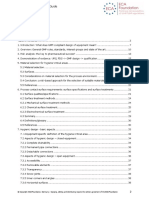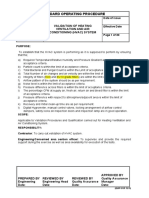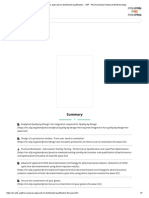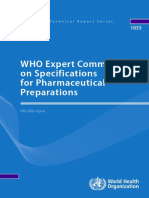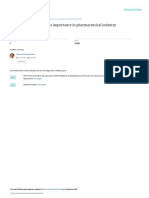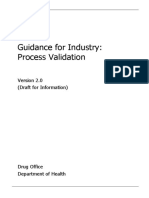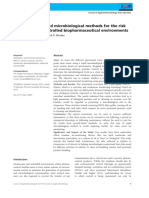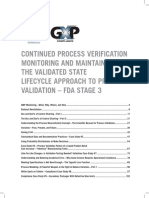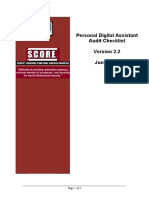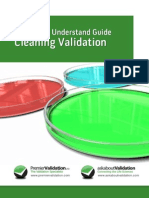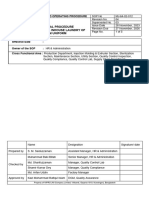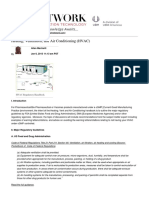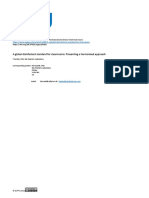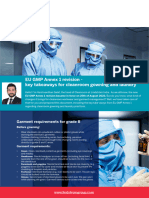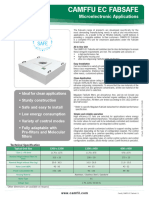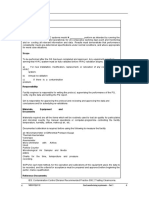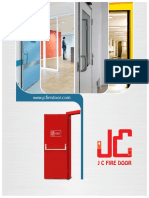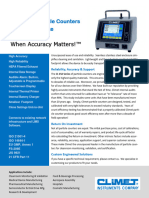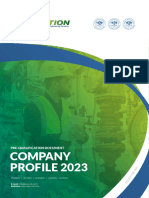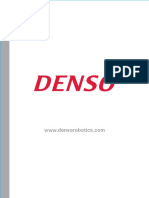Limites Microbianos Por Poisson
Limites Microbianos Por Poisson
Uploaded by
Javier GalvanCopyright:
Available Formats
Limites Microbianos Por Poisson
Limites Microbianos Por Poisson
Uploaded by
Javier GalvanOriginal Title
Copyright
Available Formats
Share this document
Did you find this document useful?
Is this content inappropriate?
Copyright:
Available Formats
Limites Microbianos Por Poisson
Limites Microbianos Por Poisson
Uploaded by
Javier GalvanCopyright:
Available Formats
JVT_May2007.
qxd
4/23/07
8:04 AM
Page 196
Application of Poisson
Distribution in Establishing
Control Limits for Discrete
Quality Attributes
B Y P R A M O T E C H O L AY U D T H
INTRODUCTION
This article is written as a complement to one recently
published entitled Establishing Alert Limits for Microbial Counts in Purified Water, which appeared in this Journal Volume 13, Number 1, November 2006. In the current
paper, the scope will be expanded i.e., establishing control
limits for discrete quality data attributed to products, raw
materials, and critical system outputs, which also include
the microbial counts in Purified Water as discussed in the
previous article. The establishment criterion will remain the
same i.e., using historical data and the Control Chart principle where, in this article, the control limits are simply derived from the Poisson distribution that is corresponding in
distribution pattern to the original Binomial distribution.
DISCRETE QUALITY ATTRIBUTES
Control limits for discrete quality attributes may be
found in the following areas:
Trend Data Analysis For example, establishing
trend limits for:
Microbial counts in raw materials, products,
and Water for Pharmaceutical Use (WPU)
Environmental Monitoring (EM) microbial
levels in production areas
196
Journal of Validation Technology
Validated Products For example, establishing:
Control limits for numbers of tablets rejected
from an online Metal Detector during tablet
compression cycle
Control limits for numbers of containers rejected from visual inspection of sterile production batches
Release limits for microbial counts in nonsterile products
Validated Critical Systems For example, establishing:
Alert limits for microbial levels in cleanroom
environment
Alert limits for microbial counts in Water for
Pharmaceutical Use (such as Purified Water or
Water for Injection)
UNDERSTANDING OF POISSION
DISTRIBUTION
When we repeatedly take samples of the same size n =
90 from a population containing only conforming (say, 95%
of the population) and non-conforming (5%) items, the
counts of non-conformities will distribute according to both
Binomial and Poisson distributions (Figure 2). Poisson is a
special case of Binomial where n and p 0.
(Continued on page 198)
JVT_May2007.qxd
4/23/07
8:04 AM
Page 197
Pramote Cholayudth
Figure 1
Binomial and Poisson Probability Density Functions (PDFs)
Figure 2
Binomial and Poisson Distributions
Probability (%)
(Non-Conforming Rate: p=5% =0.05, n=90)
22%
20%
18%
16%
14%
12%
10%
8%
6%
4%
2%
0%
Binomial Dist, Mean = np = 4.5, SD = (npq)^0.5 = 2.07
Poisson Dist, Mean = np = 4.5, SD = (np)^0.5 = 2.12
9 10 11 12 13 14 15 16 17 18 19 20
Number of Success
M a y 2 0 0 7 Vo l u m e 1 3 , N u m b e r 3
197
JVT_May2007.qxd
4/23/07
8:04 AM
Page 198
Pramote Cholayudth
(Continued from page 196)
The two distribution curves illustrated in Figure 2 indicate that the parameter np = 90x0.05 or 4.5 is sufficient to
construct a Poisson distribution that is quite similar in shape
to the Binomials. It is also suggested by statisticians that np
< 5 can generate the common shape between Binomial and
Poisson distributions. (Interested readers may discover
more in Statistics textbooks.)
Using the Control Chart principle and data above, comparison of the control limits for np Chart (Binomial distribution) and c Chart (Poisson distribution) will be as noted in
Figure 3.
(c )
ESTABLISHING CONTROL LIMITS
Control limits for discrete quality attributes may be established as below:
Collect appropriate amount of data (at least ten individual test or measurement results)
Compute for the average value of all results ( c )
Compute for the control limits using c 3 c
principle
However, c 4 c and c 6 c
may be
applied, as alert and action limits, respectively,
to the microbial levels to compensate the
possible sampling and testing technique errors
Since alert and action limits for microbial
levels in aseptic areas are also required, the
limits
c2 c
and c 4 c
may be
applied respectively (see Figure 12)
Justify the established limits before use by plotting
c Chart using that particular data
Revise the limits as appropriate when the database
is larger
Figure 3
Control Limits Based on np and c Charts
np Chart Approach
c Chart Approach
The results in Figure 3 imply that the control limits in discrete numbers established from
both Binomial and Poisson approaches are practically the same especially for np < 5.
198
Journal of Validation Technology
JVT_May2007.qxd
4/23/07
8:04 AM
Page 199
Pramote Cholayudth
MICROBIAL ALERT LIMITS
PARTICLE COUNT IN CLEANROOM
Comparison of alert limits, using np Chart according to
the previously published article (JVT Vol. 13, No. 1, Nov.
06) and c Chart for microbial counts in Purified Water is
provided in Figure 4.
In the c Chart Approach column, the limits data (in discrete numbers) are the same as those in the np Charts.
Therefore the c Chart method can be practically used in
place of the np method and also has an advantage over it
since only the averaged count of non-conformities ( c ) is
employed without taking the sample size into account. In
Figure 6 the c value up to 7.5 (> 5) still generates the same
discrete data limits (0, 18) although the distribution area has
slipped from the Binomials.
Particle count in non-unidirectional cleanroom (turbulent air) is typical discrete data. In theory, its distribution
should follow a Binomial/Poisson distribution. Measuring
the particle counts at a fixed location in a cleanroom area at
time series will generate different measured values that
require to be evaluated. Since an area may have k sampling
locations based on the area size (i.e., rounded integer of
=
square root of the area in m2), the averages ( x ) for these
locations measurements require to be computed for the
=
grand average ( x ) and standard deviation (SD). The 95%
upper confidence limit (95% UCL) using the formula
x + t 0.05, k 1 (SD / k ) is then computed to demonstrate
that it still meets the designed cleanliness requirement.
(Continued on page 202)
Figure 4
Comparison of Control Limits Using np and c Charts Principle
np Chart Approach
c Chart Approach
M a y 2 0 0 7 Vo l u m e 1 3 , N u m b e r 3
199
JVT_May2007.qxd
4/23/07
8:04 AM
Page 200
Pramote Cholayudth
Figure 5
Alert Limits for Microbial Count in Purified Water at Points of Use
Microbial Count Distribution in Purified Water
(Count Mean: 2.06 CFU/mL, Action Limit: 100 CFU/mL)
30%
Binomial
Frequency (%)
25%
Poisson
20%
15%
10%
5%
0%
0
10
12
14
16
18
20
Microbial Count (CFU/mL)
Figure 6
Alert Limits for Microbial Count in Purified Water at Washing Area
Microbial Count Distribution in Purified Water (+Hose)
(Count Mean: 7.5 CFU/mL, Action Limit: 100 CFU/mL)
16%
14%
Binomial
Binomial
Poisson
Poisson
Frequency (%)
12%
10%
8%
6%
4%
2%
0%
0 2
8 10 12 14 16 18 20
22 24 26 28 30 32 34
Microbial Count (CFU/mL)
200
Journal of Validation Technology
JVT_May2007.qxd
4/23/07
8:04 AM
Page 201
Pramote Cholayudth
Figure 7
Alert Limits for Microbial Count in Purified Water after RO Unit
Microbial Count Distribution in Purified Water (after RO)
(Count Mean: 3.9 CFU/mL, Action Limit: 100 CFU/mL)
25%
Binomial
20%
Frequency (%)
Poisson
15%
10%
5%
0%
0
10
12
14
16
18
20
22
24
Microbial Count (CFU/mL)
Figure 8
Alert Limits for Microbial Count in Purified Water after EDI Unit
Frequency (%)
Microbial Count Distribution in Purified Water (after EDI)
(Count Mean: 5.3 CFU/mL, Action Limit: 100 CFU/mL)
20%
18%
16%
14%
12%
10%
8%
6%
4%
2%
0%
Binomial
Poisson
10
12
14
16
18
20
22
24
Microbial Count (CFU/mL)
M a y 2 0 0 7 Vo l u m e 1 3 , N u m b e r 3
201
JVT_May2007.qxd
4/23/07
8:04 AM
Page 202
Pramote Cholayudth
(Continued from page 199)
Computing the UCL is based on the Central Limit Theorem
i.e., the mean (averaged) values of samples (of appropriate
size) even taken from a non-normal population will follow a
normal distribution. The air turbulence will influence the
particle count measurement biased far beyond what it should
be. So, computing using the Binomial or Poisson principle is
not practical since the resulting UCL will be much lower
than that from the Central Limit Theorem principle.
ESTABLISHING CONTROL LIMITS FOR
REJECTED CONTAINERS
The number in each batch of sterile product containers
rejected due to their failure to pass the visual inspection is
also a discrete type data. Establishing the acceptance limits
for these rejected containers is essentially required. In a
pharmaceutical plant where the author provides consulting
service, one set of data for containers rejected after visual
inspection from ten batches of an Infusion product has
been collected. Their control limits are established as seen
in Figure 9.
In addition to the established overall control limits (38,
86), control limits for individual types of defects (particles,
glasses, and fibers) are separately established due to their
different sources of contamination (Figure 10). Such limits
are useful as the tools for analysis and improvement of individual defect rates. It was suggested that Production continuously improve to reduce the numbers of those defects
and subsequently adjust the control limits using the defect
data after the improvement. Training and qualification (OQ
and PQ) of the visual inspection process was also recommended. Figure 10 demonstrates how the greater values, up
to 62, of the averaged counts of non-conformities ( c ) are
still justified for using the Poisson distribution approach.
Using the overall limit information, standard yield limits
for production batches can be established as in Figure 11.
LIMITATION OF POISSON
APPLICATION
There are some limitations for the application use of
Poisson distribution. Some types of counts of non-confor
mities (or numbers of defects) data with the average ( c )
greater than x or smaller than y may fail to generate the
proper control limits since Poisson distribution may not
exist. The values of x (expectedly high) and y (expect-
Figure 9
Control Limits for Rejected Containers
Batch #
1
2
3
4
5
6
7
8
9
10
Average ( c )
UCL
LCL
Particles
13 (min)
32 (max)
18
21
19
26
22
18
27
19
21.5
35
8
UCL = c + 3 c , LCL = c 3 c
202
Journal of Validation Technology
Glasses
Fibers
14
7 (min)
16
8
12
12
15
20
14
21 (max)
16
17
19
38
9 (min)
39 (max)
36
33
25
34
26.6
42
11
13.9
25
3
Overall
43
56
53
67
40 (min)
77 (max)
73
71
66
74
62
86
38
JVT_May2007.qxd
4/23/07
8:04 AM
Page 203
Pramote Cholayudth
edly low) require to be identified. From a preliminary trial
and error experiment, x is probably 100 and y is 1. In any
case, it is strongly recommended to justify the established
control limits prior to use and periodically review during
their use.
Appropriate handling of the data is very important e.g.,
for microbial counts in Purified Water, the zero result (denoted as < 1) is preferably transformed to 1 before computation of the alert limits. Regarding microbial levels in an
aseptic processing environment, it is more justified to di-
rectly use the zero (0) for computing the alert and action
limits. In Figure 12, two approaches for establishing control
limits for environmental microbial levels are provided. The
cumulative frequency approach was introduced by Robert
A. Fry 6 i.e., 95% and 99% confidence levels are set as the
alert and action limits, respectively, based on non-normal
data. Two sets of limit results (cumulative and c Chart) are
to be evaluated for justification by plotting as c Charts. The
most valid set of limits is selected.
For the high-valued data of which the value is greater
Figure 10
Distributions of Rejected Containers
Poisson Distributions: Rejected Containers
Glasses
Mean = 13.9
12%
Fibers
Mean = 26.6
10%
Frequency (%)
Particles
Mean = 21.5
8%
Total
Mean = 62.0
6%
4%
2%
0%
0
5 10 15 20 25 30 35 40 45 50 55 60 65 70 75 80 85 90 95
Number of Rejected Containers
Figure 11
Yield Information: Standard Yield Limits
Yield Descriptions
Quantities (containers)
Theoretical Yield
3,921 ( = 400x1000/102)
Number of QC Samples
24
Control Limits Rejected Containers
UCL: 86
LCL: 38
Standard Yield Limits
UL: 3,859* (98.42 %)
LL: 3,811** (97.19 %)
Batch size: 400.- liters, target fill volume: 102 mL/container
* UL (Upper Limit) = 3,921- 24 - 38 = 3,859, ** LL (Lower Limit) = 3,921- 24 - 86 = 3,811
M a y 2 0 0 7 Vo l u m e 1 3 , N u m b e r 3
203
JVT_May2007.qxd
4/23/07
8:04 AM
Page 204
Pramote Cholayudth
than 100, the Poisson distribution will have a limitation to
exist. However, bear in mind that the data of interest is the
non-conformity (defect) data; these should be as low as possible. Establishing control limits for high defect numbers
means we are accepting high defect rates poor quality
which is the wrong concept. In any case, if such limits are
really required, it is necessary to collect the data from
smaller samples so that reduced defect numbers fulfilling
the Poisson PDF requirements are obtained. The new data
can be then converted to control limits.
CONCLUSION
Historical, discrete quality attribute data in sufficient
quantity are averaged ( c ) to estimate the mean of the entire
Poisson distribution, the basic control limits are then com
puted using c 3 c principle. These particular data must
be obtained from the same size of samples taken at random.
The established control limits are justified before use and
periodically evaluated (i.e., reviewed and revised) as appropriate. Justification is undertaken by plotting the limits-establishing data on the c Chart to verify the fitting ability of
the limits. All control limits, established based on data, are
reviewed or revised on a periodic basis. The evaluating frequency is another interesting issue where its justification is
required. From a quality assurance (QA) point of view, it is
good practice to carry out the periodic evaluation of such
control limits.
ABOUT THE AUTHOR
Pramote Cholayudth is Executive Director of
Valitech Co., Ltd., a well-established validation and
compliance consultant services company for the
Pharmaceutical Industry in Thailand. He is a guest
speaker on Process Validation to Industrial Pharmaceutical Scientists organized by the local FDA. Mr.
Cholayudth was a full-time lecturer in a School of
Pharmacy in a private university for four years (19982001). Prior to entering the academic arena, he
spent 23 years in the Pharmaceutical Industry with
Bayer Laboratories (1974-1981) and OLIC (Thailand)
Limited (1981-1997) a leading, and the largest,
pharmaceutical toll manufacturer for multinational
companies. Pramote is the author of Concepts and
Practices of Pharmaceutical Process Validation. He
is currently a respected, contributing member of
JVT's Editorial Advisory Board. Pramote can be contacted by fax at 662-740-9586, by e-mail at
cpramote2000@yahoo.com, or at the following mailing address:
Figure 12
Approaches for Establishing Control Limits for Microbial Levels
Cumulative Frequency Approach
Results
(CFU/Plate)
%
Occurrence
0
1
2
3
4
5
86
9
2
1
1
1
Cumulative
Frequency (%)
86
86+9 = 95
95+2 = 97
97+1 = 98
98+1 = 99
99+1 = 100
c Chart Approach
Control Limits
(Poisson)
Average
(CFU/Plate)
0.00*
0.09*
0.04*
0.03
0.04
0.05
Alert Limit:
Overall
= 0.25
= 0.25 + 2
=1
Action Limit:
= 0.25 + 4
=2
Alert Limit: 1 CFU/plate (95% Confidence)
Alert Limit: 1 CFU/plate
Action Limit: 4 CFU/plate (99% Confidence)
Action Limit: 2 or 3** CFU/plate
* 0x(86/100) = 0.00; 1x(9/100) = 0.09; 2x(2/100) = 0.04, ** =
204
Journal of Validation Technology
0.25
0.25 + 5 0.25
0.25
JVT_May2007.qxd
4/23/07
8:04 AM
Page 205
Pramote Cholayudth
Pramote Cholayudth
6/756 Number One Complex,
Bangkok-Ram 2 Road,
Pravate District, Bangkok, 10250
Thailand
REFERENCES
1. WHO Technical Report Series # 929, Thirty-ninth Report,
Annex 3: WHO Good Manufacturing Practices: Water for
Pharmaceutical Use, World Health Organization, 2005.
2. Center for Drug Evaluation and Research (CDER),
Guidance for Industry, Sterile Drug Products Produced
by Aseptic Processing - Current Good Manufacturing
Practice, September 2004.
3. Ad Hoc GMP Inspections Services Group, EC Guide to
Good Manufacturing Practice, Revision to Annex 1,
Manufacture of Sterile Medicinal Products, May 30, 2003.
4. The United States Pharmacopoeial Convention, Inc.,
General Information Chapter <1116> Microbiological Evaluation of Clean Rooms and Other Controlled Environments,
United States Pharmacopoeia 27th Edition, Philadelphia,
PA: National Publishing.
5. Besterfield, D. H., Quality Control, Sixth Edition, Prentice
Hall, 2001.
6. Fry, R. A., CQA Microbiology Support, Presentation on
Environmental Monitoring: Establishing Action and Alert
Levels, PDA Spring Conference, Orlando, Florida, March
11-13, 2002.
7. Wadsworth, H. M., Stephens, K. S., and Godfrey, A. B.,
Modern Methods for Quality Control and Improvement,
Second Edition, John Wiley & Sons, 2002.
Article Acronym Listing
EDI
EM
IPC
LCL
OQ
PQ
QA
RO
SD
UCL
WPU
Electrodeionization
Environmental Monitoring
In-Process Control
Lower Control Limit
Operational Qualification
Probability Density Function
Performance Qualification
Quality Assurance
Reverse Osmosis
Sample Standard Deviation
Upper Control Limit
Water for Pharmaceutical Use
M a y 2 0 0 7 Vo l u m e 1 3 , N u m b e r 3
205
You might also like
- Validation Master PlanDocument56 pagesValidation Master PlanMd Nazim Uddin100% (8)
- ?GMP Compliant Equipment Design?ECA Guideline?Document5 pages?GMP Compliant Equipment Design?ECA Guideline?jacky786No ratings yet
- Environmental Monitoring Incubation Conditions - JustificationDocument4 pagesEnvironmental Monitoring Incubation Conditions - Justificationveerreddy_157808No ratings yet
- Standard Operating Procedure: Validation of Heating Ventilation and Air Conditioning (Hvac) SystemDocument20 pagesStandard Operating Procedure: Validation of Heating Ventilation and Air Conditioning (Hvac) SystemMaryanthony Namyalo100% (3)
- Cleaning Validation Guidelines - A Complete ListDocument11 pagesCleaning Validation Guidelines - A Complete ListSanjay SharmaNo ratings yet
- Comprehensive Quality by Design for Pharmaceutical Product Development and ManufactureFrom EverandComprehensive Quality by Design for Pharmaceutical Product Development and ManufactureGintaras V. ReklaitisNo ratings yet
- Test Method Validation For Cleaning Validation SamplesDocument10 pagesTest Method Validation For Cleaning Validation Samplespraba karanNo ratings yet
- The European Approach To Disinfectant Qualification. - A3P - Pharmaceutical Industry & BiotechnologyDocument7 pagesThe European Approach To Disinfectant Qualification. - A3P - Pharmaceutical Industry & BiotechnologyfarNo ratings yet
- Using A PQRI Approach in Process ValidationDocument18 pagesUsing A PQRI Approach in Process ValidationmthilekkumarNo ratings yet
- Goverde ECAGuidelineDeviationofEMdatanon SterilesproductsDocument16 pagesGoverde ECAGuidelineDeviationofEMdatanon SterilesproductsIbrahim BouzinaNo ratings yet
- Evaluation Reporting of Results Core Document PDFDocument6 pagesEvaluation Reporting of Results Core Document PDFParkhomyukNo ratings yet
- Annex 2 - 55 Report - HBELs Cleaning ValidationDocument19 pagesAnnex 2 - 55 Report - HBELs Cleaning ValidationKarla Emilia Valencia RamírezNo ratings yet
- Microbiological Pharmaceutical Quality Control LabsDocument7 pagesMicrobiological Pharmaceutical Quality Control LabsDede Kizzy Black100% (1)
- TRS 957 (2010) - Annex 3 - WHO GMP For Pharmaceutical Products Containing Hazardous SubstancesDocument17 pagesTRS 957 (2010) - Annex 3 - WHO GMP For Pharmaceutical Products Containing Hazardous SubstancesQuang Hiếu NgôNo ratings yet
- Llenado Aseptico PDFDocument20 pagesLlenado Aseptico PDFLucia Rodriguez AguilarNo ratings yet
- The Use of Risk Assessment Tools For MicDocument8 pagesThe Use of Risk Assessment Tools For MicYanNo ratings yet
- Liquinox Cleaning ValidationDocument12 pagesLiquinox Cleaning Validationdnagent007No ratings yet
- Cleaning Validation and Its Importance in Pharmaceutical IndustryDocument6 pagesCleaning Validation and Its Importance in Pharmaceutical IndustryRakeshNo ratings yet
- Handling of Out of Specification Results: International Journal of Pharmaceutical Quality Assurance April 2015Document8 pagesHandling of Out of Specification Results: International Journal of Pharmaceutical Quality Assurance April 2015Pavana KharwalNo ratings yet
- Bioburden Considerations in Equipment-Cleaning Validation: Did Not Include Swab Sampling of The Transfer LinesDocument20 pagesBioburden Considerations in Equipment-Cleaning Validation: Did Not Include Swab Sampling of The Transfer LinesWa Ode FasridaNo ratings yet
- GLP or Good Laboratory PracticesDocument35 pagesGLP or Good Laboratory Practicesningsih rezekiNo ratings yet
- Understanding ISO 21501-4 12-2010 DGDocument4 pagesUnderstanding ISO 21501-4 12-2010 DGgirodadoNo ratings yet
- Guidance For Industry: Process ValidationDocument18 pagesGuidance For Industry: Process ValidationBruno DebonnetNo ratings yet
- LyophilizersDocument6 pagesLyophilizersMohammed S.GoudaNo ratings yet
- Microbiological Pharmaceutical Quality Control Labs (7 - 93) - FDADocument8 pagesMicrobiological Pharmaceutical Quality Control Labs (7 - 93) - FDAArmando SaldañaNo ratings yet
- Why The Swab Matters in Cleaning ValidationDocument3 pagesWhy The Swab Matters in Cleaning ValidationYehuda Rahmanu PuteraNo ratings yet
- Presentation Cleaning ValidationDocument38 pagesPresentation Cleaning ValidationNishit SuvaNo ratings yet
- Pharma DocumentationDocument13 pagesPharma Documentationpolygon fzc100% (1)
- Lighthouse Environmental Monitoring Systems and Regulatory ComplianceDocument40 pagesLighthouse Environmental Monitoring Systems and Regulatory ComplianceHasni MoezNo ratings yet
- Protocol PQ1Document28 pagesProtocol PQ1Tuan NguyenNo ratings yet
- 0619-0622 (1072) Disinfectants and AntisepticsDocument4 pages0619-0622 (1072) Disinfectants and Antisepticsdaizhussain004100% (2)
- ECA Cleaning ValidationDocument4 pagesECA Cleaning ValidationGabrielNo ratings yet
- Usp 1116 Pres Mar 2016Document40 pagesUsp 1116 Pres Mar 2016Omar FaruqNo ratings yet
- q8, q9, q10 Question and AnswersDocument16 pagesq8, q9, q10 Question and AnswersJorge Humberto HerreraNo ratings yet
- Application of Rapid Microbiological MetDocument11 pagesApplication of Rapid Microbiological Metkranti.amipolymer14No ratings yet
- Compressed Gases in Pharmaceutical FacilitiesDocument7 pagesCompressed Gases in Pharmaceutical Facilitiesraju1559405100% (1)
- 23635.1.5. Application of The F0 Concept To Steam Sterilisation of Aqueou - PDFDocument1 page23635.1.5. Application of The F0 Concept To Steam Sterilisation of Aqueou - PDFlilaNo ratings yet
- Filterintegritytesting-Sartorious Application NoteDocument8 pagesFilterintegritytesting-Sartorious Application NoteVijay Kumar NandagiriNo ratings yet
- Preservative Efficacy TestingDocument3 pagesPreservative Efficacy TestingrambhadesiNo ratings yet
- Evaluation Study For Determination of Quantities of Disinfectant Solution Used For Fogging of Clean Rooms With Respect To Area VolumeDocument6 pagesEvaluation Study For Determination of Quantities of Disinfectant Solution Used For Fogging of Clean Rooms With Respect To Area VolumeSurjeet SamantaNo ratings yet
- A Pocket Guide To AuditingDocument10 pagesA Pocket Guide To Auditingmanojdhamne5802No ratings yet
- CreatingaCleaningValidationPlan TOCDocument1 pageCreatingaCleaningValidationPlan TOCOnichan21No ratings yet
- Sutton - JGXP .14.3 PDFDocument9 pagesSutton - JGXP .14.3 PDFFaisal AbbasNo ratings yet
- 0707-0712 (1117) Microbiological Best Laboratory PracticesDocument6 pages0707-0712 (1117) Microbiological Best Laboratory PracticesoliveluvpopayNo ratings yet
- AQBD Seminar TMUDocument19 pagesAQBD Seminar TMUPharma Life-cycle ConsultancyNo ratings yet
- WHO TRS-970-46th-2012Document250 pagesWHO TRS-970-46th-2012shonuneenu100% (1)
- Continuing Process Verification - 1Document106 pagesContinuing Process Verification - 1Noemi100% (2)
- Personal Digital Assistant Audit Checklist June 2009: Page 1 of 7Document7 pagesPersonal Digital Assistant Audit Checklist June 2009: Page 1 of 7T&J HR OFFICIALNo ratings yet
- ObjectionableDocument9 pagesObjectionabledmtalbhogeNo ratings yet
- Analytical HPLC Method DevelopmentDocument107 pagesAnalytical HPLC Method DevelopmentVinay PatelNo ratings yet
- Cleaning Validation Volume III PDFDocument87 pagesCleaning Validation Volume III PDFpracesar3871100% (1)
- Documentation in Cleaning Validation 1692198553Document67 pagesDocumentation in Cleaning Validation 1692198553Mahsa AgharafieNo ratings yet
- 01 LC Vibratory Sifter 01Document2 pages01 LC Vibratory Sifter 01Ravi YadavNo ratings yet
- Cleaning Validation Boot CampDocument7 pagesCleaning Validation Boot Campramin_47No ratings yet
- Sterilization of Compendial Articles: Background and ScopeDocument6 pagesSterilization of Compendial Articles: Background and Scopemolder.chenNo ratings yet
- Transport of CellsDocument20 pagesTransport of CellsshneetsNo ratings yet
- Disinfectant QualificationDocument10 pagesDisinfectant QualificationfarNo ratings yet
- An Easy To Understand Guide To Cleaning ValidationDocument7 pagesAn Easy To Understand Guide To Cleaning ValidationEdgar Rodrigo Osorio PérezNo ratings yet
- Microbiology Audit Guidance EbookDocument23 pagesMicrobiology Audit Guidance EbookArmando Saldaña100% (1)
- Good Documentation Practices (GDP) in Pharmaceutical IndustryFrom EverandGood Documentation Practices (GDP) in Pharmaceutical IndustryNo ratings yet
- SOP - MJ-64-02-012, Inhouse LaundryDocument5 pagesSOP - MJ-64-02-012, Inhouse LaundrySaeedNo ratings yet
- ASCO Miniature Valve Products (AV017R5)Document96 pagesASCO Miniature Valve Products (AV017R5)vasudeva yasasNo ratings yet
- Environmental Monitoring GuidelinesDocument36 pagesEnvironmental Monitoring Guidelinesmadosb5133No ratings yet
- BAJU STERIL Austar Pharmaceutical & Medical Consumables-20140324Document47 pagesBAJU STERIL Austar Pharmaceutical & Medical Consumables-20140324Fithrul مباركNo ratings yet
- Essential Microbiology For GXP Compliance PDFDocument117 pagesEssential Microbiology For GXP Compliance PDFRaj Kishore100% (3)
- Selecting Particle Count Points For A Continuous FMS System - Manufacturing & Packaging - NG Pharmaceutical Europe - GDS PublishingDocument3 pagesSelecting Particle Count Points For A Continuous FMS System - Manufacturing & Packaging - NG Pharmaceutical Europe - GDS PublishingDavide GrioniNo ratings yet
- IVT Network - Heating, Ventilation, and Air Conditioning (HVAC) - 2013-05-06Document7 pagesIVT Network - Heating, Ventilation, and Air Conditioning (HVAC) - 2013-05-06sohaib389892No ratings yet
- Graver Catalog 2012 PDFDocument76 pagesGraver Catalog 2012 PDFAskar HarisNo ratings yet
- A Global Disinfectant Standard For CleanDocument9 pagesA Global Disinfectant Standard For CleanAyman EshraNo ratings yet
- RLS Lindstrom Annex 1 SummaryDocument4 pagesRLS Lindstrom Annex 1 SummaryBibin RajNo ratings yet
- CAMFFU EC FabSafeDocument1 pageCAMFFU EC FabSafehenrycamfilNo ratings yet
- Smoke StudiesDocument7 pagesSmoke StudieszombiecorpNo ratings yet
- Ag 60 PDFDocument2 pagesAg 60 PDFankur_haldarNo ratings yet
- Range Brochure PDFDocument148 pagesRange Brochure PDFOlavRueslattenNo ratings yet
- Air Shower BrochureDocument8 pagesAir Shower Brochureimscastro1No ratings yet
- Format PQ WHODocument6 pagesFormat PQ WHODono WayNo ratings yet
- Fed STD 209e PDFDocument57 pagesFed STD 209e PDFramyNo ratings yet
- Cleanroom Recommended Gowning ProtocolDocument3 pagesCleanroom Recommended Gowning Protocolks aksNo ratings yet
- Pt1019 Ezine WatermarkDocument80 pagesPt1019 Ezine WatermarkMd. JewelNo ratings yet
- Fire DoorsDocument12 pagesFire DoorsAjayy VaghelaNo ratings yet
- List Recognized Standards Medical Devices Guidance CanadaDocument35 pagesList Recognized Standards Medical Devices Guidance CanadaRobert SplinterNo ratings yet
- CI 154 SeriesDocument2 pagesCI 154 SeriespalbarraNo ratings yet
- Role and Calculation of Air Changes Per Hour in Clean Room AreaDocument3 pagesRole and Calculation of Air Changes Per Hour in Clean Room AreaF. A AhmedNo ratings yet
- PDA Bookstore ESeries Flyer - OrderformDocument2 pagesPDA Bookstore ESeries Flyer - OrderformTim SandleNo ratings yet
- 2311 - EES Company ProfileDocument142 pages2311 - EES Company Profileمحمود عبدةNo ratings yet
- Dr. Tim Sandle Pharmaceutical Microbiology ResourcesDocument65 pagesDr. Tim Sandle Pharmaceutical Microbiology ResourcesCatrinescu OanaNo ratings yet
- DENSO Robotics Catalog D2277470 PDFDocument52 pagesDENSO Robotics Catalog D2277470 PDFjohnNo ratings yet
- Bioburden:The Burden On Our Biological OperationsDocument48 pagesBioburden:The Burden On Our Biological OperationsSurendar Kesavan100% (1)

